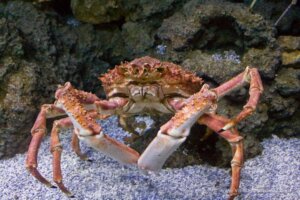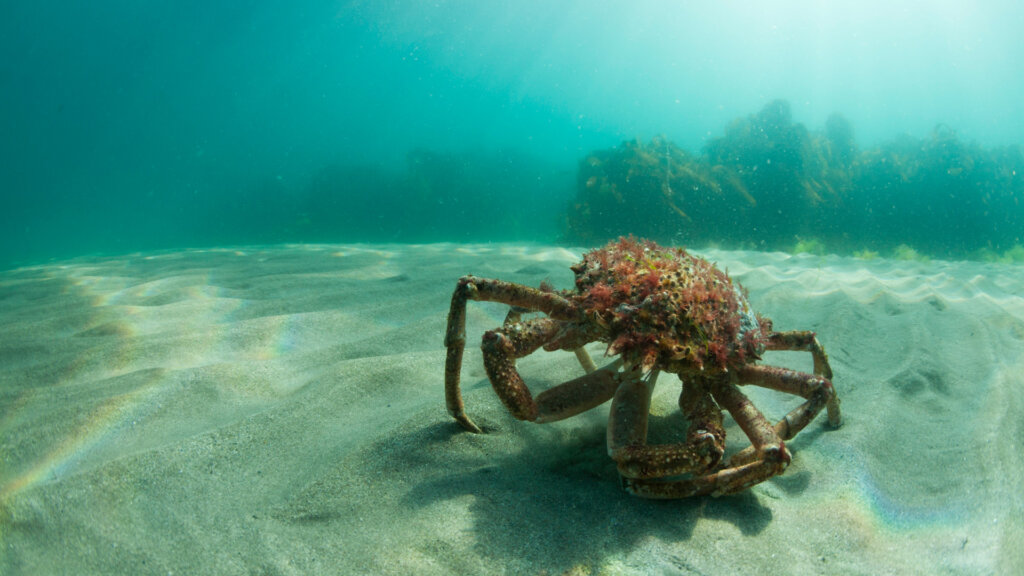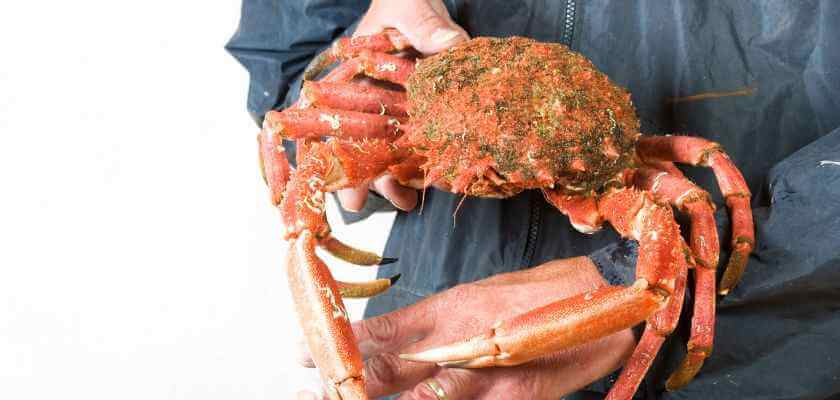European Spider Crab: Habitat, Characteristics and Reproduction


Written and verified by the psychologist Sara González Juárez
If you have ever seen a spider crab, it has probably been in the fish tanks of the seafood shop windows. The truth be known, this animal isn’t very well known apart from in this particular setting, and most of the research is focused on its breeding in captivity for human consumption.
However, in its habitat, it’s a living being that has as many surprises up its claws (!) as any other. As a fundamental part of benthic ecosystems, it’s essential that we show the natural side of this crustacean, and not only the breeding and eating aspects. For this reason, in this article, you’ll find all the biological characteristics of this crustacean, with nothing left out. Let’s get on with it!
Taxonomy and characteristics

The European spider crab, like the rest of the crab family, belongs to the decapods order, that is, animals with 10 legs. Its scientific name is Maja squinado and is included in the Majidae family, which includes another 200 species characterized by the frontal spines of its exoskeleton.
Of its 10 legs, 2 have evolved into the characteristic front claws, but in their ancestors these only had a locomotor function. Males have larger ones than females and both use them to catch prey and handle food in general. The female specimens, on the other hand, have a more bulky belly to accommodate the eggs.
They’re large crustaceans weighing almost 6 kilograms (just over 13 pounds) and 60 centimeters (nearly 24 inches) in diameter. Their calcareous carapace has spicules all over their backs, giving them extra protection against predators. Its color varies from brown to reddish depending on the habitat, as this is its way of camouflaging itself against the seabed and rocks.
Spider crab diet
This crustacean is considered omnivorous, as it feeds on a great variety of organisms in its environment. Its diet also varies with the season. It usually chooses algae and other mollusks in winter, but tends to feed more on echinoderms and sea cucumbers during the warm seasons.
In addition, they also tend to consume detritus found on the seabed. This is where its most important role for the ecosystem lies, the elimination of waste, because, without creatures like these, the balance of the biome they inhabit wouldn’t be possible.
Habitat
As mentioned above, it’s an animal that moves along the seabed. It doesn’t swim, but walks on the surface and seeks refuge in rocky areas. It can be found up to 150 meters depth (nearly 500 feet).
It’s one of the most abundant invertebrates on the continental shelf.
The European spider crab, the species that concerns us, is found in the northwest of the Atlantic Ocean and in the Mediterranean Sea, as well as on the African coast up to Guinea. They’re exclusive to salty waters, so they’ll never be found in any rivers that flows into these waters.
Spider crab behavior
The spider crab is a crustacean with migratory habits. Although these migrations aren’t particularly long (they do not usually exceed 100 kilometers – 60 miles), it should be noted that they become sociable during this period, since they’re heading to their breeding sites to mate and they need protection.
At this moment they’re vulnerable, since they have just molted their shells, so staying together with others of their species increases their protection.
Their camouflage behavior is also curious, as they usually sit on algae, shells, and other elements in their environment to go unnoticed. Depending on their age, they live either closer to, or farther from, the coast; the adults are the ones that move offshore.
Reproduction
Females mate after molting, in autumn, when their new shell is softer, which in turn facilitates the storage of eggs and copulation. The congregations of migrating spider crabs (usually about 20 per group) move to the breeding sites and there the females lay about 15,000 eggs, although this number can even increase to 30,000.
The females can lay up to 4 times each year.
At the time of laying, the female also releases the semen that the male has deposited in the so-called seminal well, where it accumulates and is stored for up to 6 months. In this way, external fertilization takes place. Then she attaches them to her belly and transports them for 7-8 weeks until their hatching.
Crab conservation

At present, the spider crab isn’t considered to be in danger of extinction. Even so, its fishing is regulated in most countries and it’s also bred in captivity for human consumption, as some populations started to reduce.
However, overexploitation is always a clear danger, as these crustaceans obtain high prices the market. This is why we should never ignore the actions humans carry out for their own benefit, as everything that’s worth good money tends to disappear at some point if it isn’t controlled.
If you have ever seen a spider crab, it has probably been in the fish tanks of the seafood shop windows. The truth be known, this animal isn’t very well known apart from in this particular setting, and most of the research is focused on its breeding in captivity for human consumption.
However, in its habitat, it’s a living being that has as many surprises up its claws (!) as any other. As a fundamental part of benthic ecosystems, it’s essential that we show the natural side of this crustacean, and not only the breeding and eating aspects. For this reason, in this article, you’ll find all the biological characteristics of this crustacean, with nothing left out. Let’s get on with it!
Taxonomy and characteristics

The European spider crab, like the rest of the crab family, belongs to the decapods order, that is, animals with 10 legs. Its scientific name is Maja squinado and is included in the Majidae family, which includes another 200 species characterized by the frontal spines of its exoskeleton.
Of its 10 legs, 2 have evolved into the characteristic front claws, but in their ancestors these only had a locomotor function. Males have larger ones than females and both use them to catch prey and handle food in general. The female specimens, on the other hand, have a more bulky belly to accommodate the eggs.
They’re large crustaceans weighing almost 6 kilograms (just over 13 pounds) and 60 centimeters (nearly 24 inches) in diameter. Their calcareous carapace has spicules all over their backs, giving them extra protection against predators. Its color varies from brown to reddish depending on the habitat, as this is its way of camouflaging itself against the seabed and rocks.
Spider crab diet
This crustacean is considered omnivorous, as it feeds on a great variety of organisms in its environment. Its diet also varies with the season. It usually chooses algae and other mollusks in winter, but tends to feed more on echinoderms and sea cucumbers during the warm seasons.
In addition, they also tend to consume detritus found on the seabed. This is where its most important role for the ecosystem lies, the elimination of waste, because, without creatures like these, the balance of the biome they inhabit wouldn’t be possible.
Habitat
As mentioned above, it’s an animal that moves along the seabed. It doesn’t swim, but walks on the surface and seeks refuge in rocky areas. It can be found up to 150 meters depth (nearly 500 feet).
It’s one of the most abundant invertebrates on the continental shelf.
The European spider crab, the species that concerns us, is found in the northwest of the Atlantic Ocean and in the Mediterranean Sea, as well as on the African coast up to Guinea. They’re exclusive to salty waters, so they’ll never be found in any rivers that flows into these waters.
Spider crab behavior
The spider crab is a crustacean with migratory habits. Although these migrations aren’t particularly long (they do not usually exceed 100 kilometers – 60 miles), it should be noted that they become sociable during this period, since they’re heading to their breeding sites to mate and they need protection.
At this moment they’re vulnerable, since they have just molted their shells, so staying together with others of their species increases their protection.
Their camouflage behavior is also curious, as they usually sit on algae, shells, and other elements in their environment to go unnoticed. Depending on their age, they live either closer to, or farther from, the coast; the adults are the ones that move offshore.
Reproduction
Females mate after molting, in autumn, when their new shell is softer, which in turn facilitates the storage of eggs and copulation. The congregations of migrating spider crabs (usually about 20 per group) move to the breeding sites and there the females lay about 15,000 eggs, although this number can even increase to 30,000.
The females can lay up to 4 times each year.
At the time of laying, the female also releases the semen that the male has deposited in the so-called seminal well, where it accumulates and is stored for up to 6 months. In this way, external fertilization takes place. Then she attaches them to her belly and transports them for 7-8 weeks until their hatching.
Crab conservation

At present, the spider crab isn’t considered to be in danger of extinction. Even so, its fishing is regulated in most countries and it’s also bred in captivity for human consumption, as some populations started to reduce.
However, overexploitation is always a clear danger, as these crustaceans obtain high prices the market. This is why we should never ignore the actions humans carry out for their own benefit, as everything that’s worth good money tends to disappear at some point if it isn’t controlled.
All cited sources were thoroughly reviewed by our team to ensure their quality, reliability, currency, and validity. The bibliography of this article was considered reliable and of academic or scientific accuracy.
- Centollo. (s. f.). Ministerio de Agricultura y Pesca de España. Recuperado 18 de noviembre de 2022, de https://www.mapa.gob.es/es/ministerio/servicios/informacion/centollo_tcm30-102473.pdf
- WoRMS – World Register of Marine Species. (s. f.). https://www.marinespecies.org/aphia.php?p=taxdetails
- Neumann, V. (1998). A review of the Maja squinado (Crustacea: Decapoda: Brachyura) species-complex with a key to the eastern Atlantic and Mediterranean species of the genus. Journal of Natural History, 32(10-11), 1667-1684.
- Hines, A. H., Wolcott, T. G., González-Gurriarán, E., González-Escalante, J. L., & Freire, J. (1995). Movement patterns and migrations in crabs: telemetry of juvenile and adult behaviour in Callinectes sapidus and Maja squinado. Journal of the Marine Biological Association of the United Kingdom, 75(1), 27-42.
This text is provided for informational purposes only and does not replace consultation with a professional. If in doubt, consult your specialist.








